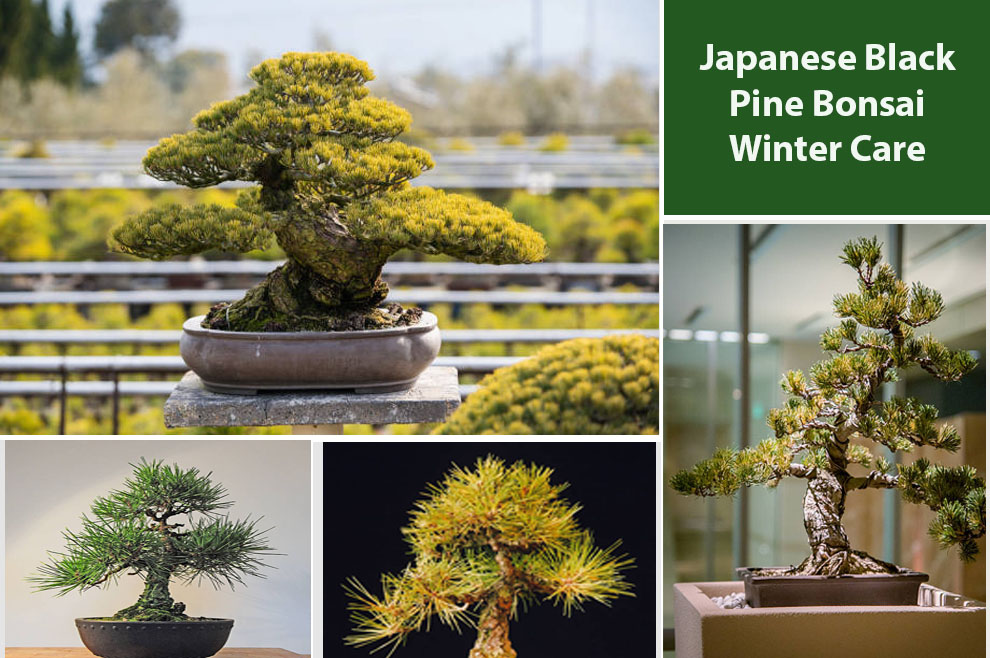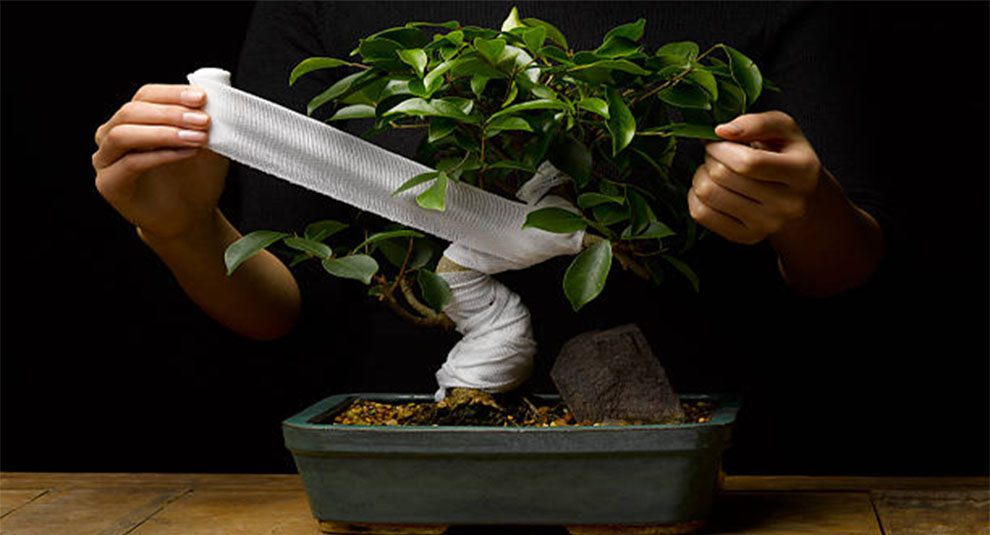Japanese Black Pine Bonsai Winter Care – How To Keep Them Alive?
Japanese Black Pine Bonsai’s winter survival hinges on proper care. Maintain cool temperatures, provide adequate light, and water sparingly. Shield from frost, prune minimally, and adjust fertilizer use. These are key to keeping them alive and thriving.

Japanese Black Pine stands as an emblem of timeless elegance and enduring beauty. These miniature trees, meticulously shaped and nurtured, evoke a sense of tranquility and admiration.
However, as winter’s chill descends upon us, even these hardy bonsai specimens require special attention to thrive through the frosty months.
Whether you’re a novice enthusiast or a seasoned professional, the art of Japanese Black Pine Bonsai winter care is a vital skill to master.
In this comprehensive guide, we will discuss the intricacies of preserving the vitality and grace of these bonsai treasures during the harsh winter season.
We will delve into the nuances of selecting the right location, adjusting temperature and light, proper watering techniques, and essential pruning methods.
Moreover, we’ll share expert insights and common pitfalls to ensure your Japanese Black Pine Bonsai not only survives but thrives during the winter months.
So, let’s get to the key focus areas to keep your Japanese black pine bonsai thriving and enchanting year-round.
Bonsai Trees and Winter – Do They Get Along Well?
Winter can be a formidable adversary for bonsai trees, making proper winter care crucial. Firstly, the drop in temperature can stress and damage these delicate specimens, potentially causing irreversible harm.
The reduced sunlight during winter exacerbates the situation, affecting their energy production.
Furthermore, cold winds can lead to excessive moisture loss, drying out the bonsai. The most significant challenge lies in frost, which can freeze the roots and tissues, leading to severe injury or death.
Understanding these challenges underscores the importance of meticulous winter care, ensuring that bonsai not only survives but continues to thrive through the harshest season.
Japanese Black Pine Bonsai Winter Hardiness
Japanese Black Pine Bonsai exhibits impressive winter hardiness. Its adaptability to cold temperatures and ability to withstand frost makes it a robust choice for bonsai enthusiasts.
With proper care, this bonsai pine tree variety can endure harsh winter conditions, retaining its beauty and vitality throughout the season.
Do You Need Specialized Tools and Supplies for Winter Japanese Pine Bonsai Care?
These specialized tools and supplies are crucial for maintaining the health and appearance of Japanese Black Pine Bonsai during the winter months.
Bonsai Shears or Pruners: These are used for delicate pruning and maintenance to shape the bonsai during winter. Trimming excess growth helps maintain the desired form.
Root Rake: Root maintenance is crucial in winter. A root rake is used to gently comb and prune roots, improving soil health and facilitating aeration.
Bonsai Wire: Essential for branch positioning and training during the dormant season. It helps you shape the bonsai as desired.
Bonsai Soil: Proper soil is vital for winter care. Bonsai soil should be well-draining with good aeration, ensuring the roots remain healthy.
Frost Cloth or Burlap: These materials provide protection from frost and cold winds, preventing damage to the bonsai.
Watering Can with a Fine Nozzle: In winter, precise and controlled watering is essential. This tool allows you to water without disturbing the soil or roots.
Insecticides and Fungicides: Winter care includes protecting the bonsai from pests and diseases. These products are used as preventive measures.
Japanese Black Pine Bonsai Winter Care
Knowing how to take care of Japanese pine bonsai in winter is essential for preserving the elegance of these miniature trees.
This guide will navigate you through the intricacies of nurturing and protecting these treasures during the frosty months.
A. Can Japanese Black Pine Bonsai Survive Winter Indoors?
Depending on your climate, choose indoor or outdoor placement. In colder regions, indoors is best to shield the bonsai from freezing temperatures.
Outdoors can work in milder climates with wind protection. Indoors, maintain a cool room with bright, indirect sunlight to mimic its natural habitat.
B. Temperature and Light Considerations:
Maintain temperatures between 32-50°F (0-10°C) and provide adequate light. Japanese Black Pine Bonsai benefits from a cool, well-lit environment during winter.
C. Soil Amendments in Winter:
Ensure well-draining soil with good aeration for Japanese black pine bonsai in winter. Avoid heavy, water-retentive soils that can lead to root rot in winter.
D. Watering During Winter:
Water sparingly but regularly to prevent drying out. Japanese Black Pine Bonsai prefers slightly moist soil during winter.
E. Protection Against Frost:
Shield the bonsai from frost using burlap or frost cloth. Avoid direct contact with cold surfaces.
F. Fertilizer Use in Winter:
Reduce or suspend fertilizer during winter for Japanese black pine bonsai during winter. Allow the bonsai to rest and conserve energy.
G. How To Trim Japanese Black Pine Bonsai?
Minimal pruning during winter; focus on structural adjustments and removing dead or diseased branches. Regularly inspect and clean the bonsai to prevent pests and diseases.
Related: Japanese Pine Tree Varieties
Common Mistakes To Avoid For Winter Bonsai Care

Avoiding common mistakes is crucial for successful Japanese Black Pine Bonsai maintenance in winter. Here are some pitfalls to steer clear of:
Overwatering: One of the most common mistakes is overwatering during winter. With reduced sunlight and cooler temperatures, the bonsai’s water requirements decrease. Overwatering can lead to root rot.
Using Heavy, Water-Retentive Soil: Inappropriate soil can hinder drainage, causing root problems. Ensure the soil is well-draining and aerated to prevent waterlogged roots.
Exposing Bonsai to Freezing Temperatures: Japanese Black Pine Bonsai is hardy but not immune to frost damage. Avoid placing it in extremely cold locations without protection.
Improper Pruning: Over-pruning during winter can stress the bonsai. Limit pruning to dead or diseased branches and structural adjustments.
Ignoring Pests and Diseases: Winter care should include monitoring for pests and diseases. Neglecting this can lead to infestations that harm the bonsai.
Neglecting Wind Protection: Cold winds can dry out the bonsai. Shield it from harsh winds using barriers like burlap or frost cloth.
Conclusion
In conclusion, learning how to care for Japanese pine bonsai in winter is a testament to the artistry and dedication of bonsai enthusiasts.
By adhering to these guidelines, you ensure that your bonsai remains resilient and enchanting throughout the cold season.
As winter blankets the landscape, your bonsai can thrive indoors or outdoors, provided the right conditions are met. Precise temperature control, thoughtful lighting, and well-draining soil are the foundation of successful care.
Watering, though reduced, is essential to prevent drying out, while frost protection safeguards against winter’s bite.
Remember, bonsai care in winter is a harmonious blend of science and art. Pruning, while minimal, should align with the bonsai’s natural grace, and fertilizer use should be adjusted for a well-deserved rest.
Lastly, vigilance against pests and diseases is crucial for maintaining your bonsai’s health.
As you embark on this journey of winter care for your Japanese Black Pine Bonsai, you not only preserve its beauty but also deepen your connection with the ancient art of bonsai cultivation.
With patience and meticulous attention, you ensure that your bonsai remains a source of inspiration and admiration, even in the coldest months.
